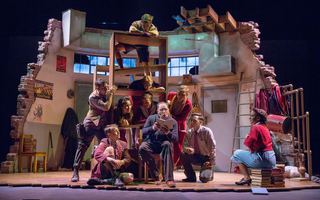Practitioners use elements of theatre composition to organise components of a theatre production to create a deliberate effect, realising their aims and intentions and those of the creative production team.
The Study Design for VCE Theatre Studies explains that the elements of theatre composition can be used to give structure to the interpretation or the way it is presented on stage in performance to an audience. These elements can also be used to encourage or lead the audience to engage in the work. They can be applied individually or in combination, in any theatre style, used within any production role and at any stage of the production process.
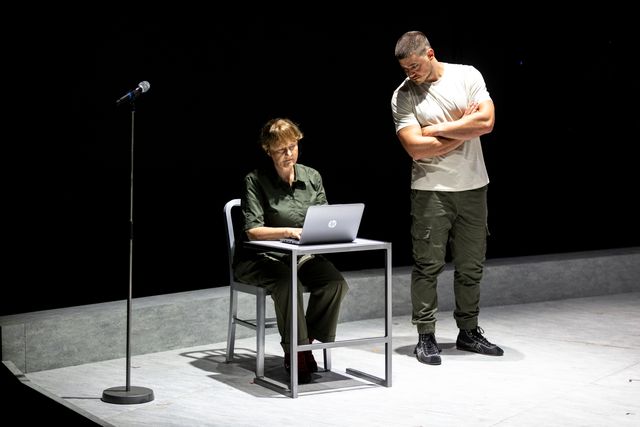
COHESION
The unity and balance of various aspects of the interpretation.
Bell Shakespeare’s Henry 5, is structured around the ideology that we are always an audience to war. Director Marion Potts’ approach to Henry 5 allows the audience to see the effects of war from the context of the present, past and future. Interpreting factual evidence, anecdotal accounts and more recently, the media’s portrayal of war and the perceived heroes within it, the audience witnesses the theatrical retelling of a leader stirring his troops to victory. The Chorus is used as a voice between the action and the audience. Actors take turns speaking into a microphone centre stage, while another actor types vigorously on a laptop stage right. The words displayed on a surtitle* screen imply that the Chorus’ words are being transcribed into a digital text, allowing the audience to make the connection between documentation and allegation. The cohesion of electronic visuals and amplification of diegetic sounds, which are threaded throughout classical text, allows the audience to place these war-torn countries in any place or time.
The costumes are simple and modern. With the use of contemporary military patterns, such as camouflage or streetwear clothing including cargo pants. The cohesion of military prints and casual clothing that would be seen in the streets today allows the audience to have a visceral connection with the characters, displaying the ‘everyday person’ who is then asked to enact brutality under the banner of war.
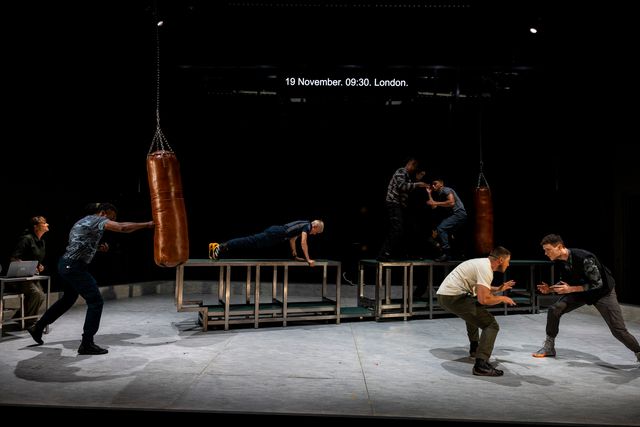
MOTION
The movement or implied movement of actors and design features in the theatre space. This may include position, pattern, arrangement, proportion and spatial flow.
A deliberately young cast, the actors work vigorously on stage. A steel-framed gantry is pushed, pulled and flipped during the action of the play in fluid and seamless motion to create the different worlds of the play, by the athletic and muscular cast.
Early within the play, the English engage in a combat training circuit wherein the actors are preparing for war. The actors embark on a number of exercises, using a suspended punching bag, continuously jumping over the gantry, performing pushups, pullups, sparring, rolling over and crawling under and through the metal structure like a jungle gym for combat. They run with fury and focus on a continuous track around the set and stage in a coordinated motion.
Many of the war scenes are stylised to demonstrate to the audience that we are seeing a reenactment of war.
Before the battle, mud is sprawled across the stage to create a realistic and visceral experience of the Battle of Agincourt, a famously muddy field. As the battle commences, the actors run in the mud, starting in a slower pace, demonstrating the hesitation of running towards their death. As the character of King Henry picks up in pace, so do his troops. Climatically, they run furiously with as much speed as they can muster as they come into contact with the French.
During the battle, a split frame is used when one actor mimes an attack on another, and both actors are facing the audience. One actor puts their hand out as if they are choking someone, while an actor at the opposite side of the stage reacts, coughing and struggling to breathe, while they fight for their life.
As the battle concludes, the actors tirelessly retreat to centre backstage and fall exhausted into a heap of bodies. This image depicts the tragic aftermath of war, and the stillness and lifelessness of the bodies juxtapose with the preceding pace and action. Some dead, some barely alive, they lie slumped together as a mass. Slowly, Henry emerges to receive the news of his victory.
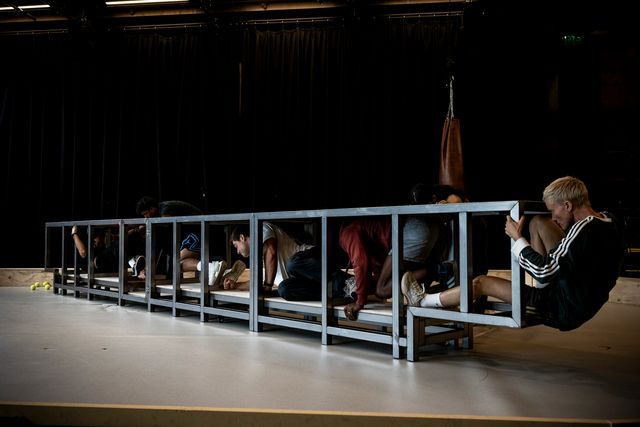
RHYTHM
The pace, timing and tempo within the interpretation.
Rhythm plays an important role in this production by linking sound and movement. It helps transport the audience to a time of war. When Henry condemns his three friends to death for betrayal, the sudden silence and stillness break the play’s fast pace. This change highlights the seriousness of the moment. A similar effect is used in the trench scenes, where a mix of prerecorded music and live audio creates a dark, sombre rhythm beneath the dialogue.
To illustrate to the audience the English advancing into enemy territories as they invade France, the actors take turns slowly climbing through the tight space of the gantry. The use of physical gestures to each other in close proximity and contrast of movement to moments of complete stillness illuminates the impending bloody battle that the soldiers will soon embark upon.
The high energy movement of the troops contrasting with the stillness of court and aristocratic scenes, allows the audience to see the two sides of war. One of hungry and passionate lower-class soldiers camping and preparing for battle; the other, a more polished and clinical world of power, politics, religion and monarchy.
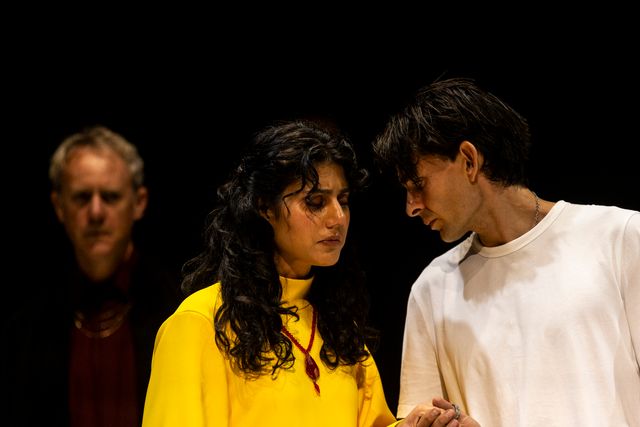
EMPHASIS
Aspects of the interpretation are given a particular focus, importance or prominence.
Three prominent themes in the play – race, religion and patriarchy/patriarchal legacy - are present in every war we experience, today and in Henry 5
Henry 5 highlights the enduring themes of race, religion, and patriarchy, emphasising their prominence in both historical and modern conflicts, shaping interpretations through their persistent influence on war and society.
In one of the opening scenes, Henry is gifted tennis balls from the Dauphin, the heir to the French throne. It is a deliberate reference to Henry‘s youthful days of sport and debauchery. The bright green tennis balls are thrown across the stage, scattering and luminescent against a set largely devoid of colour. The moment is surprising, and often prompts the audience to laugh, a deliberate juxtaposition of the serious conversation at hand. The joke makes Henry even more resolved to fight the French, and while playful in his response, his seriousness undercuts the levity of the moment.
The cast for this production are mainly young actors. This deliberate choice emphasises the dehumanising nature of military culture, where young men are expected to harden themselves into ruthless soldiers, stripping them of their humanity in the name of war.
The female characters are in a battle of their own, struggling to assert their voices and resist the patriarchal control that seeks to dominate both their bodies and their agency. This is emphasised by the costume choice of Princess Katherine. She is the only character whose costume is not ‘Streetwear’. She wears a striking, long-sleeved, flowing garment in a rich shade of golden yellow, a stark contrast to all other costumes in the production.

CONTRAST
Juxtaposition of seemingly different or opposing aspects or qualities within the interpretation.
Perhaps the largest use of contrast in Henry 5 is through the theme of conflict. Not only are two countries at conflict with each other, Marion Potts believes one of the most crucial elements is that we are watching these characters struggle with being the best and worst versions of themselves – that is the real conflict. Valour and courage are important, but ultimately, it is the struggle, the human one, that is problematic for men in this situation.
We see this through the characterisation of Henry. A newly crowned king, Henry has changed from wayward youth to “sudden scholar” (Act 1, Scene 1). Henry is also referenced in the play as Prince Hal and Harry. This highlights his coming of age, how he is seen by others, but also the transformation of his responsibilities and maturity. The contrast of humour and seriousness shows a conflict within Henry. The scene where King Henry receives the tennis balls from the French Dauphin is laced with playful mockery, as Henry uses wit to assert his authority. This lighthearted moment sharply contrasts with the chilling seriousness of the subsequent scenes, when Cambridge, Scroop, and Grey are executed for treason, and when Bardolf is hanged for looting. While the earlier scene highlights Henry's cleverness and the absurdity of youthful arrogance, the later scenes depict the brutal consequences of betrayal, emphasising the harsh realities of leadership and the moral weight of Henry's decisions. This juxtaposition deepens the play's exploration of kingship, responsibility, and the fine line between levity and severity.
The set is also used to highlight contrast. The characters’ costumes pop, contrasting with a striking simple white backdrop and a stark stage. Hanging leather-like punching bags, green tennis balls and the steel-framed gantry are used symbolically throughout the play to create the worlds of these fighting empires. Later in the play, mud engulfs the stage as a contrasting experience for the audience to actively show the experience of the Battle of Agincourt
Costumes are also used as a focal point to demonstrate contrast between countries and also gender. During the French scenes, red hue lighting is used and during English scenes, blue hue lighting is used. Princess Katherine is the only character whose costume is not ‘Streetwear’. She wears a striking, long-sleeved, flowing garment in a rich shade of golden yellow. The fabric is smooth and drapes elegantly. The dress features a high, modest neckline and wide sleeves that flare subtly at the wrists, evoking a historical or ceremonial aesthetic. The simplicity and clean lines of the garment suggest inspiration from medieval or Renaissance fashion, though modernised simplicity, makes it modern. The red beaded necklace with a central pendant adds a striking contrast, indicating status and cultural significance.
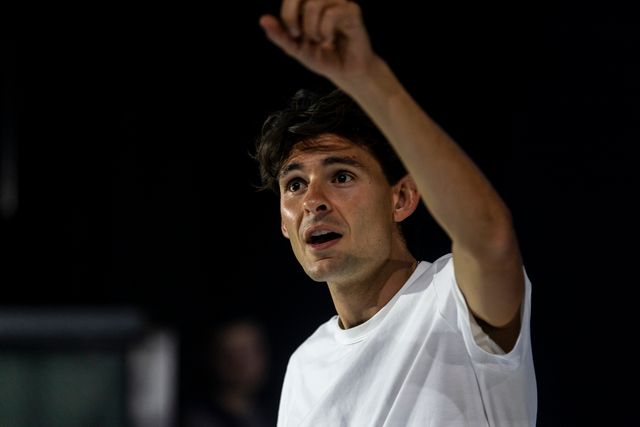
VARIATION
Changes to the dynamics of the interpretation, as may be evident in the use of tension, conflict, intensity, energy and use of the space.
Language is used as a major point of variation in the production. Marion Potts’ direction allows the audience to see an unbiased interpretation of the text. The French lines in Shakespeare's original script were predominantly written in English, and Potts has chosen to include these lines in her production in spoken French with surtitles. The musicality of the French language adds ardour and humour, while emphasising the cultural divide of the two warring nations. Although there are clear differences between the two countries, the pain, loss and effect of war are universal and felt equally by both sides evoking an empathic response from the audience.
A highlighted piece of text is the two iconic monologues performed by J.K. Kazzi in the titular role. Kazzi employs variation in tone within the rhetorical language. In Henry’s speech “Once more unto the breach”, a call to arms, urging his soldiers to fight with ferocity. JK performs this with fiery valour, while the St Crispin’s Day speech is played in a more reflective way, emphasising camaraderie and familiarity. It is an intimate choice, and differs from traditional performances of this speech. This contrast mirrors the shifting nature of war—initial excitement falling away to introspection and doubt. Henry’s ability to adapt his language and rhetoric demonstrates his leadership, transforming from a commanding force to a unifying figure. Through this variation we see both the brutality and the brotherhood of war, deepening the play’s exploration of kingship and human resilience.
